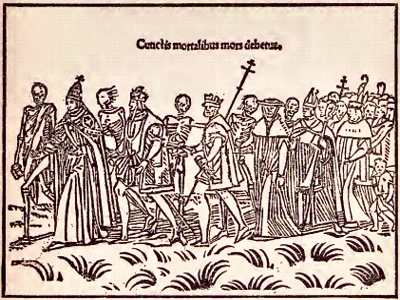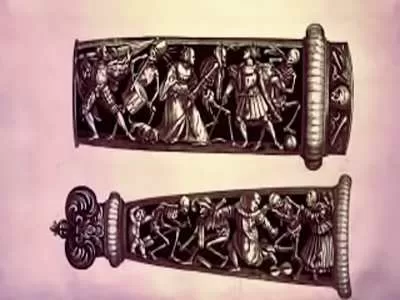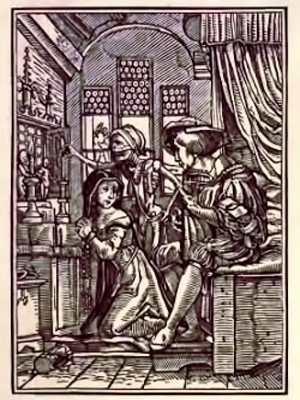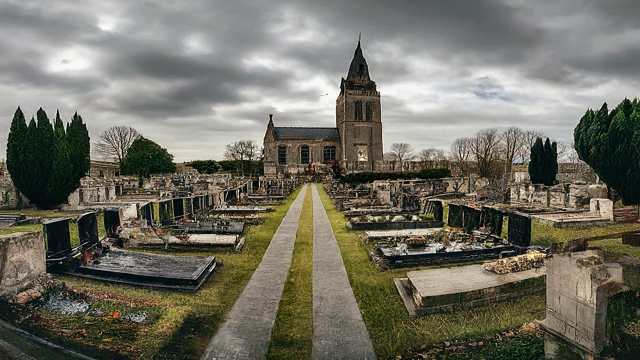In the heart of Paris, where the echoes of history resonate through cobblestone streets, lies the haunting legacy of the Dance of Death (Danse Macabre). This artistic and literary phenomenon emerged during the late Middle Ages, a period marked by plagues, famines, and a pervasive awareness of mortality.
The Dance of Death serves as a poignant reminder of the inevitability of death, transcending social status and rank, and it has left an indelible mark on art and culture.
The Origins of the Dance of Death
The Saints Innocents Cemetery (Cimetière des Saints-Innocents) was the oldest and largest cemetery in Paris, originally designed for individual burials. However, as the population grew and the demand for burial space increased, the cemetery became a site of mass graves, with pits holding up to 1,500 bodies. Charnel houses were constructed around the cemetery walls, where the bones of the deceased were stacked, creating a macabre yet practical solution to the city’s burial needs.

It was within this somber setting that one of the earliest pictorial depictions of the Dance of Death was painted. This mural, located on the south side of the cemetery, illustrated a chain of thirty figures—from the Pope and Emperor to common folk—linked hand in hand in a stately dance with Death. The imagery conveyed a powerful message: death is the great equalizer, coming for all, regardless of status or wealth.
John Lydgate’s Influence
In 1426, the English monk and poet John Lydgate visited Paris and encountered the mural as it was being completed. Captivated by its themes, he returned to England and published an interpretation of the accompanying text. His work made a significant impact, leading to the commissioning of a series of paintings of the Dance of Death for the cloister of old St Paul’s Cathedral in London. These paintings, created at great expense, were designed to accompany Lydgate’s poem, further popularizing the theme across England.

The Dance of Death became a cultural phenomenon, reflecting the anxieties of a society grappling with the specter of death. The recurring motif of memento mori—reminders of mortality—served as a call to live a virtuous life, as death could strike at any moment.
The Artistic Legacy of the Dance of Death
The popularity of the Dance of Death was bolstered by advancements in woodblock printing and the invention of the printing press by Johannes Gutenberg. This allowed for the mass production of artworks and texts, spreading the theme far and wide. One of the most notable series was created by Hans Holbein the Younger in the 1520s. His works, published in 1538 under the title Les simulachres et historiees faces de la mort, are considered masterpieces of the genre.

Holbein’s illustrations are characterized by their emotional depth and intricate detail. Each image tells a unique story, capturing the moment when Death arrives for its victims. In one poignant depiction, a nun kneels before her altar, clutching her rosary, while a young man serenades her. Unbeknownst to them, Death, disguised as an old woman, reaches out to extinguish the candle of life. This juxtaposition of the sacred and the profane highlights the fragility of existence.
In another striking image, a mother stirs a pot in a dilapidated hovel while Death leads her child away, evoking a sense of loss and helplessness. Holbein’s ability to convey complex emotions through simple yet powerful imagery resonates with viewers, reminding them of the transient nature of life.
Catacombs of Paris: A Final Resting Place
As the Saints Innocents Cemetery reached capacity in the 1760s, the decision was made to relocate the remains of the deceased to the Paris Catacombs. This underground ossuary, carved from the limestone quarries beneath the city, became a final resting place for millions of Parisians. When the mass graves were opened, workers discovered not just bones, but tons of fat—a byproduct of the anaerobic decomposition process. This unexpected finding led to the conversion of the fat into soap and candles, providing a bizarre twist to the cycle of life and death.
The catacombs serve as a stark reminder of the past, housing the remains of those who once walked the streets of Paris. Today, they attract visitors from around the world, drawn by the allure of history and the haunting beauty of mortality.
Enduring Legacy of the Dance of Death
The Dance of Death continues to resonate in contemporary culture, reminding us of our shared mortality. Its themes are echoed in literature, art, and even modern media, as society grapples with the concept of death and the inevitability of our own mortality. The Dance of Death serves as a powerful reminder that life is fleeting, and we must cherish every moment.
As we reflect on the Dance of Death, we are invited to consider our own lives and the legacies we leave behind. The art and literature inspired by this theme encourage us to confront our fears and embrace the beauty of existence, even in the face of death.
In conclusion, the Dance of Death is more than just an artistic motif; it is a profound commentary on the human condition. Through the lens of history, we can appreciate the ways in which art has captured the essence of mortality, urging us to live fully and authentically. As we continue to dance with death, let us remember to celebrate life in all its complexity and beauty.

